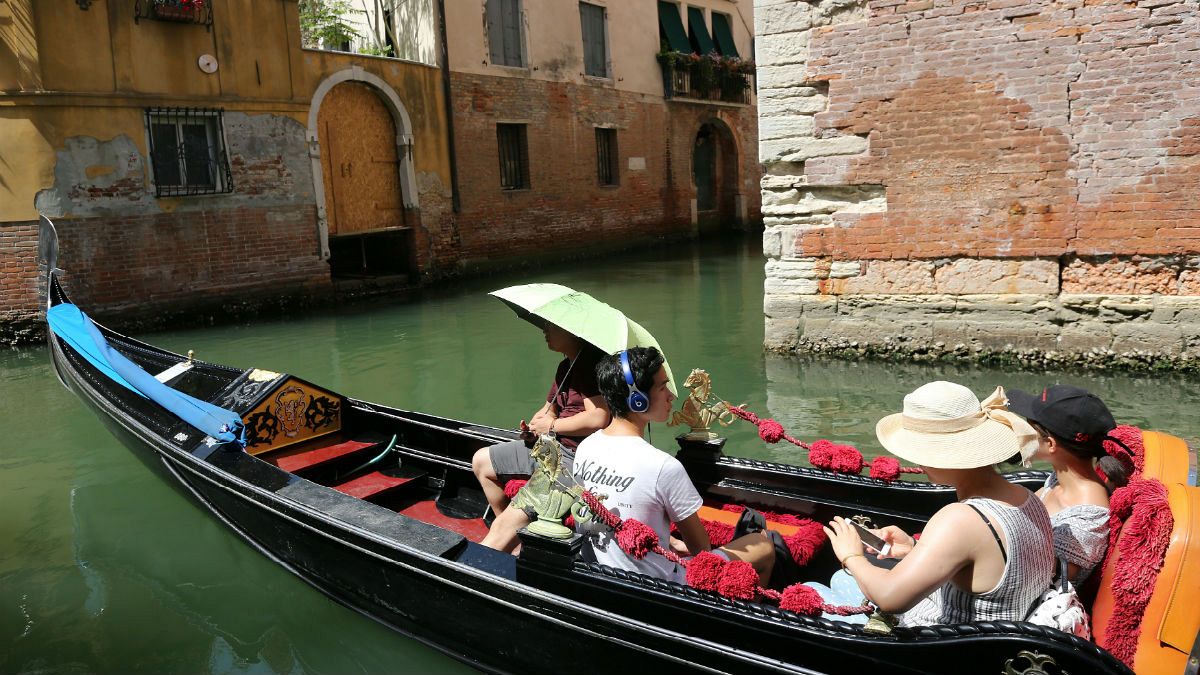Venice is sinking under the weight of tourism and locals are suffering the consequences.
Although tourism in Venice is an important source of wealth for the city, the management of huge number of visitors arriving by sea, air and land every day makes life difficult for the few remaining residents. Those who decide to stay struggle to conduct a normal life._
It’s almost impossible to find a Venetian during the day when the tourists flooding the streets dilute the local population almost to invisibility. But at night, when the locals turn on their lights they can be spotted amid the glare produced by the tourist hotels.
Many fear that the daily rhythm of tourism is turning the city into an amusement park that opens in the morning and closes as night falls, as depicted in Enrico Michieletto’s documentary Veniceland.
“I have no more neighbours,” says Elisa Mion, a 39 year old art conservator living in Venice. “Most of the restaurants, markets and traditional shops in Venice have closed, and we find it hard to buy groceries and other goods at a normal price. Everything’s planned for a touristic purpose.”
Overcrowding is not the only tourist-related problem threatening Venice – the cruise ships that bring a part of the visitors are also accused of polluting the delicate ecosystem of the city. The two problems are often conflated, but for people living in the city on the water, it’s the sheer numbers that have the biggest impact on their day to day life..
In October 2016 the municipality of Venice set up a special committee dedicated to find new strategies for managing the crowds and funneling visitors along a selected number of routes.
Discussions are still under way and since then, groups of citizens and organizations have been invited to present proposals for sustainable tourism. Among the ideas introduced is that of Generazione 90, an informal group of people created to give voice to the younger generations of Venice. They suggested a plan of structured hubs located in the access points of the city to control and regulate the entrance of tourists over the day.
But one of the hardest things to be managed in Venice is transport.
“When my work day is over, then another struggle begins, that of waiting in line, like a tourist, for a vaporetto to take me home,” Mion says.
In Venice, where cars are banned, walking up and down the bridges that connect the streets is the only alternative to boats for reaching one point or another of the city.
Mion is critical of the lack of solutions proposed by the authorities to offer public transport suited to residents.
Spiralling costs and the other challenges to leading a normal life have forced many out of the city.
According to Fabio Carrera, director of the Venice and Santa Fe Project Centers, the peak in inhabitants on Venice’s main island was reached at the beginning of the 1950s.
Today, the number has fallen down to fewer than 55,000 and drops every day. In the three decades leading up to the millennium it’s thought that half the population departed.
On the other hand, over the same period of time the number of tourists has grown by 153 percent, reaching more than 20 million trippers visiting the city in 2017.
Most of those who decided to remain, invested in one of the principle businesses of the Lagoon – hospitality.
“We decided to buy a home and to made part of it a Bed and Breakfast in 2015,” says Antonella Maione, an architect who has been living in Venice for 40 years. She had to supplement her job with additional income to make ends meet.
Despite the intense competition, particularly since the introduction of informal accommodation providers through internet flat-sharing websites, she has no intention of abandoning what has become her city.
“After all, I live in a city open to the world, with many cultural opportunities, from shows to concerts. And living here is like an obsession, something you cannot do without.”
And the city can still attract those who considers that the burden of tourism is outweighed by the benefits of one of the world’s most celebrated cities. Jack Giassai moved away when he was a student to experience how a life in a more “normal” city. He went to Rome where he has now lived for ten years. But, like many of his friends, he is searching for ways to return, even if he remains cautious.
“I already know It won’t be easy in a city that every day is sold to the needs of mass tourism,” he observes.
By Alessia Cerantola
